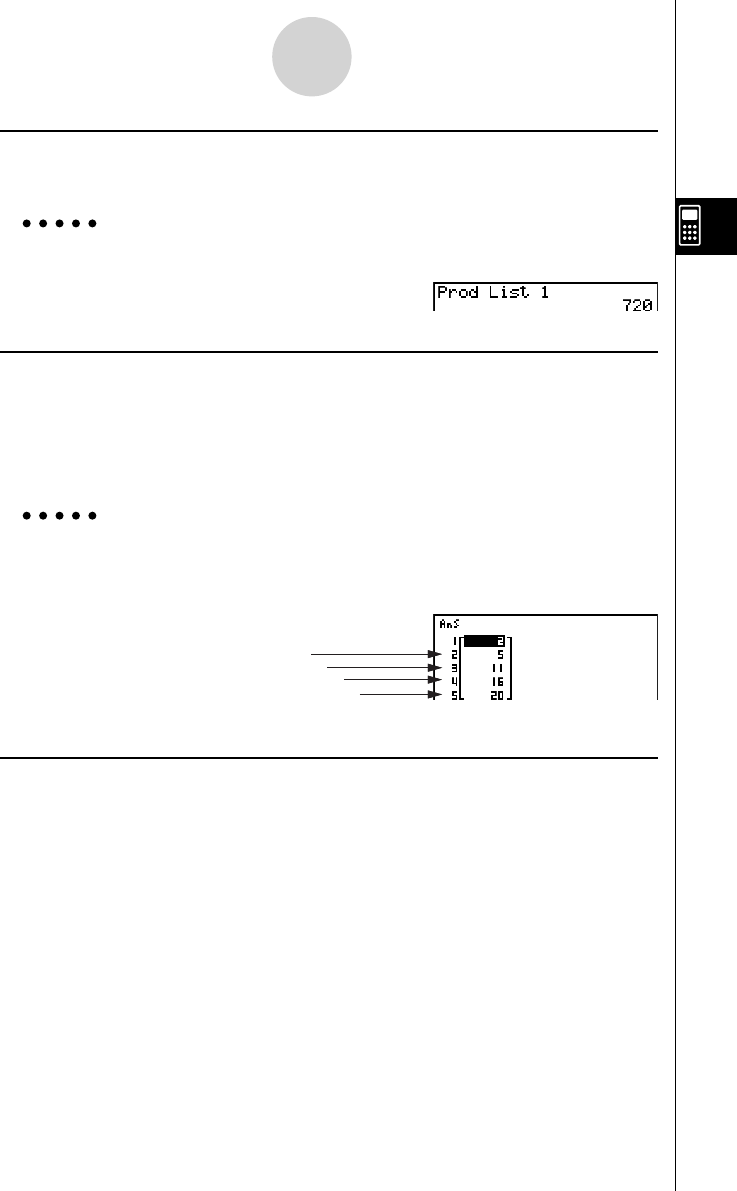User's Manual
Table Of Contents
- Quick-Start
- Precautions when Using this Product
- Contents
- Getting Acquainted— Read This First!
- Chapter 1 Basic Operation
- Chapter 2 Manual Calculations
- Chapter 3 List Function
- Chapter 4 Equation Calculations
- Chapter 5 Graphing
- 5-1 Sample Graphs
- 5-2 Controlling What Appears on a Graph Screen
- 5-3 Drawing a Graph
- 5-4 Storing a Graph in Picture Memory
- 5-5 Drawing Two Graphs on the Same Screen
- 5-6 Manual Graphing
- 5-7 Using Tables
- 5-8 Dynamic Graphing
- 5-9 Graphing a Recursion Formula
- 5-10 Changing the Appearance of a Graph
- 5-11 Function Analysis
- Chapter 6 Statistical Graphs and Calculations
- Chapter 7 Financial Calculation (TVM)
- Chapter 8 Programming
- Chapter 9 Spreadsheet
- Chapter 10 eActivity
- Chapter 11 System Settings Menu
- Chapter 12 Data Communications
- Appendix

20070201
u To calculate the product of values in a list [OPTN]-[LIST]-[Prod]
K 1 (LIST)6 (g )6 (g )2 (Prod)6 (g )1 (List)<list number 1-26>w
Example To calculate the product of values in List 1 (2, 3, 6, 5, 4)
A K 1 (LIST)6 (g )6 (g )2 (Prod)
6 (g )1 (List)b w
u To calculate the cumulative frequency of each data item
[OPTN]-[LIST]-[Cuml]
K 1 (LIST)6 (g )6 (g )3 (Cuml)6 (g )1 (List) <list number 1-26>w
• The result of this operation is stored in ListAns Memory.
Example To calculate the cumulative frequency of each data item in List 1
(2, 3, 6, 5, 4)
A K 1 (LIST)6 (g )6 (g )3 (Cuml)
6 (g )1 (List)b w
u To calculate the percentage represented by each data item
[OPTN]-[LIST]-[%]
K 1 (LIST)6 (g )6 (g )4 (%)6 (g )1 (List)<list number 1-26>w
• The above operation calculates what percentage of the list total is represented by each
data item.
• The result of this operation is stored in ListAns Memory.
2+3=
2+3+6=
2+3+6+5=
2+3+6+5+4=
2+3=
2+3+6=
2+3+6+5=
2+3+6+5+4=
3-2-7
Manipulating List Data










